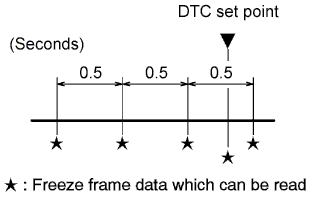Automatic Transaxle System (For Hatchback) -- Diagnosis System |
| DESCRIPTION |
When troubleshooting OBD II vehicles, the only difference from the usual troubleshooting procedure is to connect a Techstream (complying with SAE J1987) to the vehicle, and read off various data output by the vehicle's ECM.
OBD II regulations require that the vehicle's on-board computer illuminate the Malfunction Indicator Lamp (MIL) on the instrument panel when the computer detects a malfunction in the computer itself or in the drive system components which affect the vehicle emissions. In addition to illuminating the MIL when a malfunction is detected, the applicable DTCs prescribed by SAE J2012 are recorded in the ECM memory (YARIS_NCP93 RM000000W710J3X.html).
If the malfunction does not occur in 3 consecutive trips, the MIL goes off but the DTCs remain in the ECM memory.To check the DTCs, connect the Techstream to the DLC3 of the vehicle. The Techstream also enables you to erase the DTCs and check freeze frame data and various forms of engine data (For operating instructions, see the instruction book).
The DTCs include SAE controlled codes and manufacturer controlled codes. SAE controlled codes must be set as prescribed by the SAE, while manufacturer controlled codes can be set freely by the manufacturer within the prescribed limits (YARIS_NCP93 RM000000W710J3X.html).
The diagnosis system operates in normal mode during normal vehicle use. In normal mode, 2-trip detection logic is used to ensure accurate detection of malfunctions. Check mode is also available to technicians as an option. In check mode, 1-trip detection logic is used for simulating malfunction symptoms and increasing the system's ability to detect malfunctions, including intermittent malfunctions.
2-trip detection logic: When a malfunction is first detected, the malfunction is temporarily stored in the ECM memory (1st trip). If the ignition switch is turned off and then turned to ON again, and the same malfunction is detected again, the MIL illuminates.
The ECM records vehicle and driving condition information as freeze frame data the moment a DTC is stored. When troubleshooting, freeze frame data can be helpful in determining whether the vehicle was running or stopped, whether the engine was warmed up or not, whether the air/fuel ratio was lean or rich, as well as other data recorded at the time of a malfunction.
The Techstream displays freeze frame data recorded at five different points: 1) 3 times before the DTC is set, 2) once when the DTC is set, and 3) once after the DTC is set. The data can be used to simulate the vehicle's condition around the time of the malfunction. The data may be helpful in determining the cause of a malfunction. It may also be helpful in determining whether a DTC is being caused by a temporary malfunction.
 |
 |
| INSPECT DLC3 |
Check the DLC3 (YARIS_NCP93 RM000000UZ209YX.html).
| CHECK BATTERY VOLTAGE |
Measure the battery voltage.
- Standard voltage:
- 11 to 14 V
| CHECK MIL |
The MIL comes on when the ignition switch is turned to ON and the engine is not running.
- HINT:
- If the MIL does not light up, troubleshoot the combination meter.
When the engine is started, the MIL should go off. If the lamp remains on, it means that the diagnosis system has detected a malfunction or abnormality in the system.